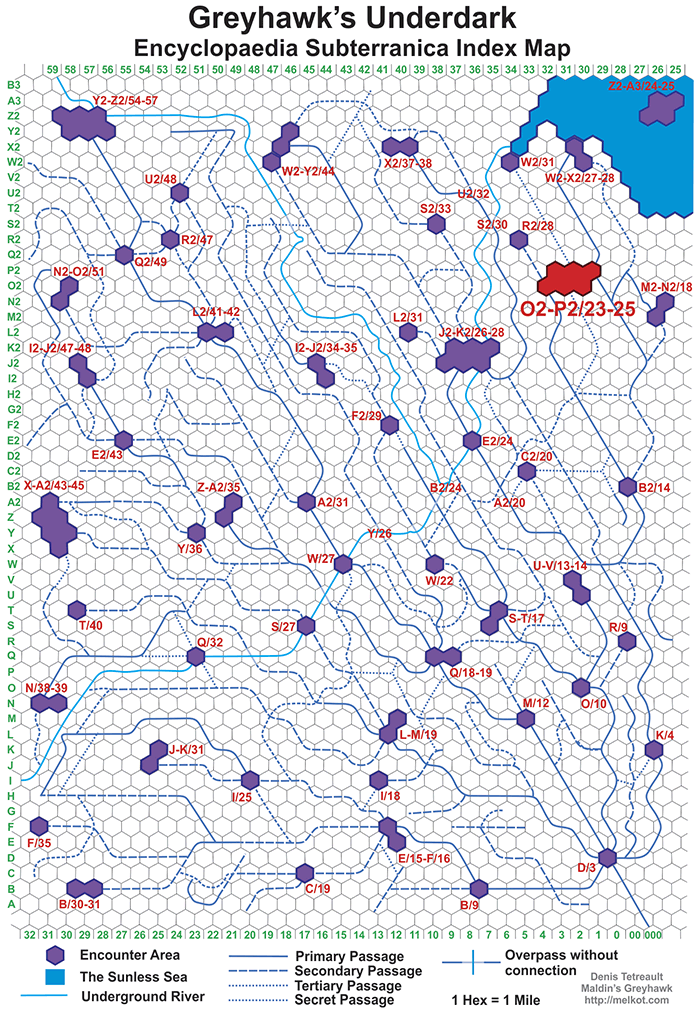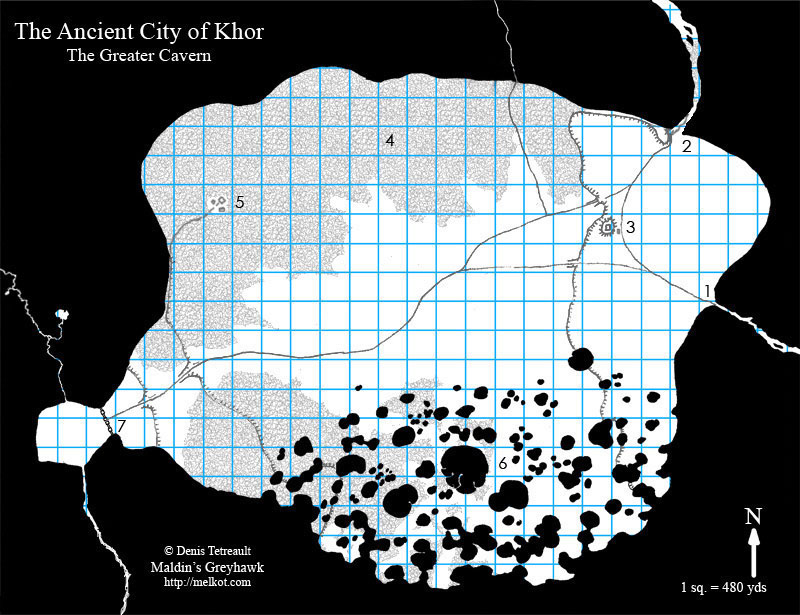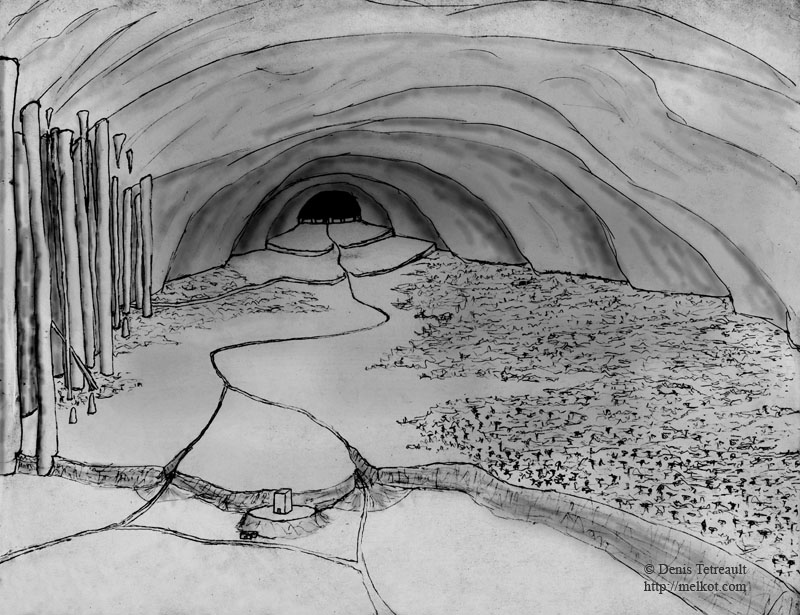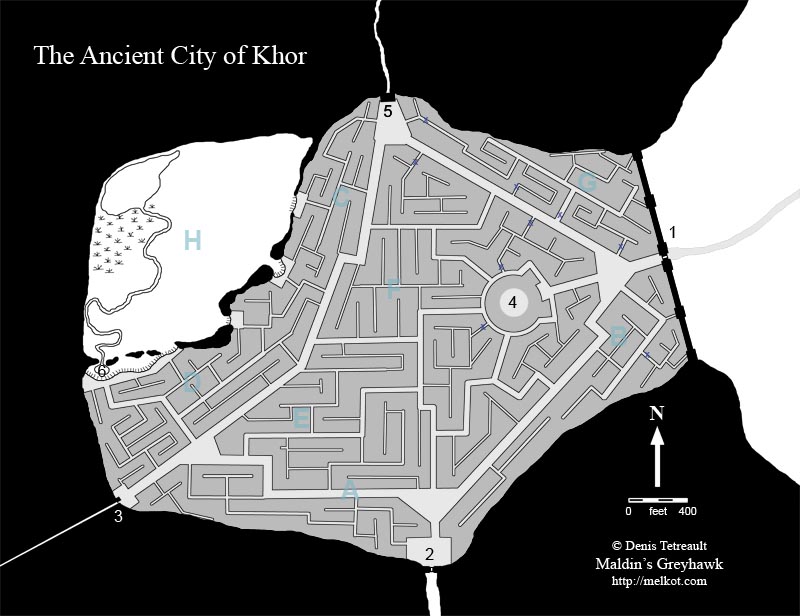









by Denis Tetreault
Version 2.5
The ancient city of Khor is located within a very large cavern located at hexes
O2-P2/23-25 on Map 14 "Underground Passages" that can be found in the adventure
D3 The Vault of the Drow, and is part of Area 1b in the large underdark
regional map. This material is part of a Dragonsfoot Collaborative
Project: Mapping
the Depths of the Earth. The latest compilation of the current state
of the project (entitled "Encyclopedia Subterranica") can be downloaded here.
As this large area is developed, I'll post further details and expansions here.
Stop by periodically.


The Greater Cavern of Khor is immense, at 5½ miles by 4½ miles, rivaling the size of the Vault of the Drow itself. Glowing slimes and fungus coating the walls and ceiling of the cavern outline its shape and bathe the expanse with extremely faint light, much fainter then the unnatural lighting of the Vault, so it is quite difficult to get a feeling for the cavern's size unless one uses magically enhanced vision. Explorers entering the cavern certainly do get a "feeling" that it is indeed immense. Using aid, such as a gem of seeing, enables an individual to truly witness the majesty of the Greater Cavern (see sketch below).
1. Many visitors to the ancient city of Khor will enter the greater cavern from the eastern tunnel. This tunnel drops gently as one heads northwest into the cavern. Most of the extensive cavern complex represented on Map 14 in D3 The Vault of the Drow to the south is at a higher elevation.then Khor, such that those with the ability to sense sloping passages will have had the feeling of going deeper down for quite some time.
2. The northeastern tunnel drops gently as it exits the Greater Cavern, and continues to slope down to the north for quite some time. Some 7 miles away, this tunnel finally opens up to a cavern of unimaginable size, and the sounds of gentle waves lapping on a shore. This is the near-mythical Sunless Sea. At one time in the distant past, the water level of the Sunless Sea was much higher. In fact, its waters reached through the (then flooded) tunnel and into the Greater Cavern (flooding it as well). Rich sediment was deposited by these waters over the floor of the cavern. As the water level of the Sea dropped, the waters retreated from this cavern in several stages, producing a series of escarpments separated by flat plains.
On the shore of the Sunless Sea at the end of the tunnel is a small satellite community where numerous fishermen ply the waters of the Sea in search of the cave fish that has become a major staple in the diet of Khor's citizens. Trade merchants bring in salt mined from elsewhere in the underdark, supplying several salting facilities in that community. Salted fish is then brought to Khor on pack-lizards, and from there a significant amount is then traded elsewhere, much of it making its way to Erelhei-Cinlu.
3. A road joins the eastern and northeastern tunnels, however it is quite clear that most traffic heads west, climbing the first escarpment through two small ravines. At this crossroads, two very different buildings can be seen. The first building is a single-story stone structure, unremarkable in nature. This guard house, built about 15 years ago, houses a small force of soldiers that collect a levy on behalf of the "government" of Khor, such as it is. Mainly it serves as a watch post and can give early warning to the city (via spell) of anything that might be a threat. The guardpost is commanded by a half-drow named Ksadik (9 fighter, HP 68, AC -4, a close friend of Kasar). The composition of his force varies, however on average there are approximately 16 guards here: 9 3rd fighter, 3 sargeants of 4th or 5th fighter, a lieutenant of 6th or 7th fighter, 2 4th or 5th level wizards, and (alternating) a 6th level drow wizard named Sanadine or a 5/5 drow fighter/wizard named Bemlen. All are armed with appropriate magical weapons, and most have magical armor (or equivalent). Personal treasures are kept at the Khor Guard barracks next to Kasar Estate.
On a nearby small mesa-like isolated section of the escarpment is a far more interesting building. This seven-story-high building stands like a massive blockhouse, composed of a black seamless, metallic-like material of unknown composition. It seems to be impervious to physical and magical damage. Many have speculated that it is some never-before seen alloy of adamantite, though most skilled sages scoff at such suggestions, claiming there may not be that much adamantite to be found throughout the entire underdark. There is only one large door, and not a single window to be found (hence the true number of interior levels is unknown). Whispers can be heard claiming that Joron Kasar is the only soul to have ever gain entry into the adamantite blockhouse, but many doubt that even he has been able to penetrate its secrets.
4. Wandering about to the north west, visitors will
find the cavern floor to be occupied by a vast fungus forest. The rich
soil supports a highly diverse fungal ecosystem, many members of which
are quite dangerous.
| Greater Cavern Fungus Forest 1 in 6, roll every hour* |
|
5. Hidden deep within the fungus forests lies a secluded cluster of buildings, the road leading to them following along a narrow and exposed stretch of the second escarpment that follows the cavern's west wall. The largest of these buildings is a temple to Lolth, while the remainder house drow hailing from Erelhei-Cinlu. While there are smaller temples to Lolth within Khor itself, this is essentially the hub of spying activity by the powers-that-be in Erelhei-Cinlu. The unpredictably rapid development of the underdark freetown of Khor to a settlement of such a size that "simple solutions" are now impossible, caught the Vault quite by surprise. Not knowing what this will mean for them, they keep a close eye on the city while contemplating what to do about it, if anything. Political instability in the Vault has also contributed to their lack of action. For now, the ruling factions of the Vault are not interfering with trade, partly because the profit outweighs the threat... so far. As such, there are two factions represented in this outpost.
The
interests of political powerbrokers (primarily the clerical leadership
of the Temple of Lolth and the associated noble houses)
of Erelhei-Cinlu are
represented by a contingent from the Female Fighters' Society. They
operate the temple and 2 smaller buildings in the complex. The size and
nature of
their force varies slightly from month to month as individuals return
to Erelhei-Cinlu after their tour of duty, and are replaced by new
troops. On
average, they maintain approximately 15 to 20 2nd level fighters (HP
10
each; AC 1; armed with +1 dagger and +1 sword), 5 4th level female
fighters (HP 24; AC -2; +2 dagger, +2 short sword, and hand
crossbow with 10 bolts), and one 6th level captain (HP 35; AC
-4; +3 dagger, +3 short sword,
atlatl and 3 javelins). None possess any treasure beyond 5-15 gp per
level, prefering to
keep
their personal valuables back at the Vault.
The interests of the merchant clans of Erelhei-Cinlu are represented by a force from the Male Fighters' Society, who maintain 3 buildings here. Their force is similar in size to the Female Society's contingent, averaging 15 2nd level fighters (HP 10 each; AC 1; +1 drow weapons, hand crossbow and 10 bolts), 4 3rd level fighters (HP 15 each; AC 0; armed as 2nd level fighters are), 2 4th level fighters (HP 21 each; AC -2; +2 drow weapons and atlatl and 3 javelins), and a 5th level captain (HP 29; +2 buckler, +3 chain mail, and +3 for 17 dexterity for an overall AC of -4; armed with +3 drow weapons). Treasure same as for the Female Fighters' Society contingent.
The outpost is commanded by Hakla, a 6th/5th cleric/fighter (HP 38; AC -4; +3 chain mail, +2 cloak of protection, 17 dexterity; armed with +3 drow weapons). Hakla successfully maintains control over the two rival groups by secretly keeping both captains as consorts. Her office and quarters are in the temple. A shared armory in the temple building contains 40 hand crossbows, 80 bolt cases with 10 quarrels each, 10 atlatls, 60 javelins, and 2 chests with 500 sleep poison applications in each. Periodically, interested parties (whether it be from one of the noble houses, merchant clans, or the Fane itself) send a special contingent (sometimes on a specific mission, sometimes just to check on things in person rather then relying on the respective Fighter Societies) of anywhere from 6 to 15 individuals. Most of that group will be a guard force similar in levels to what the Societies have here, plus a military commander of at least 6th level, and a mission leader (whether military, economic, or political) of higher level (often multiclassed as well). In other words, DMs can tailor the composition of the outpost according to the PCs levels.
6. Wander far enough to the south of the road, and explorers
will
discover one
of the true wonders of the underdark... gargantuan pillars will rise
out of the gloom, reaching up beyond the capabilities of normal vision.
Known as the Forest of Stone, or more recently as the Pillars of Khor,
these columnar speleothems formed over uncountable millennia and reach
almost ¾ of a mile up to the chamber's ceiling. While columns
are normally formed when stalactites and stalagmites continue to grow
towards each other until meeting, these particular formations are so
unusual in their massive size and cylindrical shape that their true
origins are a mystery. It is believed that the region of the
Forest is extremely dangerous, much more so then any parts of the
fungus forests, and is populated by numerous fell beasts. Intelligent
beings rarely enter. One of the guards stationed at the nearby
guardpost claims to have seen a terrifying humanoid riding an even more
terrifying giant bat-like creature swoop out of the darkness and head
back towards the forest, however his fellow guards point to his being
found behind the guardpost flat on his back passed out from excessive
drinking, and treat his report accordingly. He swears that that was the
best vantage point.

The city of Khor lies within, or rather fills entirely, a side cavern. An impressive and seemingly ageless wall of blackish metal separates the city from the rest of the cavern. This wall appears to be composed of a seamless, dark metallic substance, and has been called the Adamantite Wall. The material certainly seems to be as hard as adamantite, although it actually isn't composed of that rare metal. The wall resists all physical and magical attack forms. Its unusual properties are due to its unusual origin.
While its origins are clouded in myth and legend, the most prevalent theory is that the city of Khor was originally built by a large colony of githzerai, who arrived from Limbo and attempted to establish a major beachhead here in Oerth's underdark. While the buildings of the city are composed of local stone, the city wall is composed of material imported from Limbo. Powerful githzerai wizards formed the impregnable metallic-like substance out of the chaos of Limbo itself and brought it here. The city eventually reached a population of over 20,000 githzerai and allied races. Disbelieving sages observe that such a large population of githzerai have never been seen away from their home plane, while others conclude that the spectacular failure of this extra-ordinary colonization is the very reason why it has never been observed again. Whatever the case, not surprisingly, most of the locals would have felt rather uncomfortable having such a large population of these strange beings nearby, and likely did something about it.
After living here for an unknown time, the githzerai were eventually
wiped out, the theory continues, by an overwhelming combined force of
githyanki and drow (many
of the latter coming from the Vault of the Drow's guilds and temples).
The battle must have been devastating between these races. When the
clash of weapons, explosions of magic, and echos of psionic energy
eventually
fell silent, the remarkably intact city was abandoned. Lending credence
to this theory is the presence of rather unique githzerai, githyanki,
and drow undead. The tenuous githyanki-drow alliance didn't last much
longer then the original battle, as the githyanki, under the pretense
of directing the drow towards escaping githzerai bands, tricked them
into attacking a nearby mind flayer fortress.
Khor was
sporadically inhabited by a variety of underdark races over the years,
but never for very long. For the last 100 years, small pockets of
escaped slaves and drow outcasts tried to hide out in the many
buildings of the abandoned city, constantly struggling with the many
other less-civilized denizens that called various dark corners of the
city "home", or rather more accurately "lair".
Just over 25 years ago, a party of drow, half-drow, and half-orcs, led by a half-drow adventurer from Erelhei-Cinlu named Joron Kasar (9/9/10 F/Mu/Th) cleaned out much of the city over a long personal campaign, and set up permanent residence. It is believed that they discovered many wonderous things left behind by both the githzerai and their attacking force. Although, to this day, there are still areas of the city that contain many dangers, the mostly-safe city became very attractive to the many outcasts, escaped slaves, and underworld merchants that found other settlements in this region of the underdark to be "inconvenient" or down right "fatal", and Khor became a freetown. Many of the residents originally hailed from Erelhei-Cinlu, and much trade still is conducted with the drow capital.
Since the establishment of Khor as a freetown, the population has increased from about 400 struggling souls dispersed in pockets throughout the city, to a thriving population of over 4,000. The population continues to grow, although less rapidly then the last 10 years, as news of the new city spread quickly through Erelhei-Cinlu, quickly attracting many of those individuals who would be interested. The city continues to draw new recruits from the drow capital, though at a slower rate, many of those being merchants who are coming to realize the benefits of a new, untamed market. As stories of the reincarnation of Khor continues to spread, more come from farther and farther away. Still, there are far more buildings available then the current population requires so a large percentage are still empty. No new construction has been required since the city was first abandoned all those years ago. All of the buildings are generally squat and square two- to three-story stone constructions, built with the same austere style. Water for the population comes from several wells into a gravel aquifer that underlies the cavern. It is rumored that an unexplored undercity lies in the bedrock below the gravel layer.
The population consists of approximately 800 drow, 1000 half-drow, 250 elf-drow (cross between a surface elf and a drow), 250 half orcs, 500 duerger (primarily) and derro, 700 humans, 800 slaves (still slaves, as opposed to former-slaves, can include all the listed races, plus others, such as troglodytes), and nearly 500 other less common races (including outer-planars, svirfneblin, intelligent undead, lycanthropes, illithids, trolls, ogres, kuo-toans, gith, and much more). Khor certainly is the underdark's melting pot.
Kasar loosely rules over this motley mob with the help of a rather well-outfitted, no-nonsense mercenary force referred to as simply "the Guard". What his long-range plans are, no one knows. His hold over the city, however is more strategic, then dictatorial, and his personal power clearly more formidable because of the forces that he commands. His troops control the gates, and thus control everything that comes in or out of the city. Not only does he charge a tariff (which keeps his forces exceptionally well outfitted), but because most supplies must come via merchant train from beyond the city walls, he has the power to control resources not only to the city as a whole, but to individuals and groups as well. If there is a rising group that he anticipates might be on the verge of causing trouble, he can strangle their source of supplies coming in. If that is not enough, and they are getting their supplies internally, he will assemble a strike team and quickly eliminate any threat to his hegemony. The population (which does tend towards chaotic alignments) sometimes requires reminding, but the periodic (and always decisive) commando raids by Kasar's forces generally keeps the populace in line. Few will want to align themselves with groups that may attrack undue attention to their own activities.About twice a month o ver the past year or so, groups of a dozen or so very well outfitted troops head out of the city for destinations unknown. Each group tends to return anywhere from a week to 2 months later, however 3 of the groups have never returned.
Commodities are brought into Khor from a variety of places. Most of the food comes in through the main gate from either the fungus forest in the Greater Cavern, or from the fishing village on the shores of the Sunless Sea. Some food is harvested in other nearby caverns, while the remainder is brought in by merchant train from a variety of other underdark trading partners, Erelhei-Cinlu being the most important by far. Trade also occurs with many other underdark races, Khor's more neutral nature often serving as a trade intermediary between those races and the more xenophobic Vault of the Drow (with a percentage of the profits taken, of course).

The city wall is rumored to have been built
by the githzerai back when they occupied the city. While some scholars
believe the wall to be truly composed of some unknown alloy of
adamantite, others believe it to be formed from pure chaos-stuff
brought here by githzerai wizards, arguing that there could not
possibly be that much true-adamantite in all of Oerth. What is known is
that it is unbelievably hard and durable, impregnable to magic, and
radiates a faint signature of chaos-magic. The method by which the
seamless wall was created is a mystery, and continues to attract
researchers. The city's main gate is the one through which most of its
food comes, either harvested from the fungus forest or from the Sunken
Sea.
A fair amount of trade comes through this gate, heading south
towards Erelhei-Cinlu and other nearby underdark communities..
This smooth, straight cylindrical tunnel is quite unnatural, and was
somehow bored through solid rock by magic (or possibly an organism of
some type). After a mile and half it connects up with a natural
tunnel. Merchants transporting more valuable shipments will pony up the
toll (5% of the value of goods) for the benefit of reduced travel times
(to Erelhei-Cinlu and other underdark communities) and the safety of a
controlled path with no encounters (except for other merchants).
This arena may have been a center of highly
regimented and public martial combat when the githzerai occupied the
city. Now, pretty much anything goes. Games are scheduled on a
semi-regular basis, and usually advertised with posters in all the
local taverns. Events may feature combat between gladiators, slaves, or
creatures. PCs wishing to test their mettle should be warned that
contests often degrade to combat to the death, even if not originally
planned that way.
This is the only building other then the tower in
the greater cavern that is composed of the same adamantite-like
material as the city wall. It is from this structure that Joron Kasar
runs the city. The structure protects (and hides) the tunnel that leads
to Kasar's estate in a northern side cavern. Most of his mercenary
force is housed at the estate in a separate barracks, giving the
impression that Kasar Hall is
bursting with soldiers if one tries to count the number of troops that
come and go from this building. His force is actually larger then most
people
know, and increasing.
What isn't dumped directly into the sewer
system is dumped here. It is populated by many otyughs and neo-otyughs.
The filthy pond drains into the lower fungus cave, providing fertilizer
for all sorts of bizarre mushrooms.
At these locations, mostly found in the northern and eastern
quadrants of the city, are crudely constructed barricades that limit
(but do not prevent) movement into areas of the city that have not been
cleared of the most dangerous creatures. Undead are particularly common
in the isolated neighborhoods behind the barricades.
While there are no strict "city quarters" or areas dedicated to
specific commercial activities, different groups tend to gravitate to
each
other. Some 75 percent of the structures throughout the city are empty,
so there is no shortage of living space. Because of this, there is
really no system of property ownership. Inhabitants just live where
they want to, and often move around (leaving behind their garbage, of
course).
While most buildings are empty, even in the occupied portions of the
city, no one dares live in this area. This completely abandoned sector
of the city is still occupied by a
significant number of dangerous creatures, particularly unusual undead
(including githyanki, githzerai and drow undead). Rumor has it that
there is at least one undead githyanki knight in the area, however all
attempts to separate him from his silver sword have ended with the
separation of the fool's head from his shoulders.
This lower area serves as the city's emergency food supply in case
of attack by outside forces (which has never happened yet, in the
city's modern history). Only a fraction (the north-east corner) is
presently harvested, mainly due to the dangerous creatures found here.
The sewers of the city drain into this area (including water seeping
from the ceiling and walls of the city cavern), producing a fungus
swamp on the west side of the forest. Otyughs and neo-otyughs are
particularly common near to the sewer cascade and garbage dump in the
south west end (where inhabitants just toss their garbage over the edge
of the cliff into the lower cavern). The swamp is considered very
dangerous, and never ventured into. The small lake is also unexplored.
| Lower Fungus Cave - Dry Areas 1 in 6, roll every turn* |
Lower Fungus Cave - Swampy Areas 3 in 6, roll every turn* |
|
|
Visit my active site map to see the entire website
at-a-glance, find out whats new, and instantly jump there with just a
click.
Return to the main Greyhawk's Underdark Page
Return to the Greyhawk Locations
Page
Return to my main Greyhawk Page
(in case you got here through a search engine)